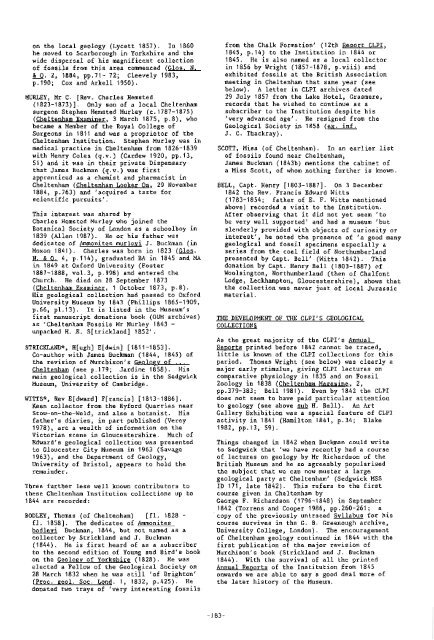Number 5 - Geological Curators Group
Number 5 - Geological Curators Group
Number 5 - Geological Curators Group
You also want an ePaper? Increase the reach of your titles
YUMPU automatically turns print PDFs into web optimized ePapers that Google loves.
on the local geology (Lycett 1857). In 1860he moved to Scarborough in Yorkshire and thewide dispersal of his magnificent collectionof fossils from this area commenced (Glos. N.0. 2, 1884, pp.71- 72; Cleevely 1983,p.190; Cox and Arkell 1950).MURLEY, Mr C. [Rev. Charles Hemsted(1823-1873)l. Only son of a local Cheltenhamsurgeon Stephen Hemsted Murley (c.1787-1875)(Cheltenham Examiner, 3 March 1875, p.8), whobecame a Member of the Royal College ofSurgeons in 1811 and was a proprietor of theCheltenham Institution. Stephen Murley was inmedical practice in Cheltenham from 1826-1839with Henry Cales (q.v.) (Cardew 1920, pp.13,51) and it was in their private Dispensarythat James Buckman (q.v.) was firstapprenticed as a chemist and pharmacist inCheltenham (Cheltenham Looker On, 29 November1884, p.763) and 'acquired a taste forscientific pursuits'.This interest was shared byCharles Hemsted Murley who joined theBotanical Society of London as a schoolboy in1839 (Allen 1987). He or his father wasdedicatee of Ammonites murlevi J. Buckman (inMoxon 1841). Charles was horn in 1823 (Glos.N. 4, pp.114), graduated BA in 1845 and MAin 1849 at Oxford University (Foster1887-1888, vo1.3, p.998) and entered theChurch. He died on 28 September 1873(Cheltenham Examiner, 1 October 1873, p.8).Hiscollection had passed to OxfordUniversity Museum by 1843 (Phillips 1865-1909,p.66, p1.13). It is listed in the Museum'sfirst manuscript donations book (OUM archives)as 'Cheltenham Fossils Mr Murley 1843 -unpacked H. E. S[trickland] 1852'.STRICKLAND*, H[ugh] E[dwin] [1811-18531.Co-author with James Buekman (1844, 1845) ofthe revision of Murchison's Geoloev of ...Cheltenham (see p.179; Jardine 1858). Hismain geological collection is in the SedgwickMuseum, University of Cambridge.WITTS*, Rev E[dward] F[rancis] [1813-18861.Keen collector from the Eyford quarries nearStow-on-the-Wold, and also a botanist. Hisfather's diaries, in part published (Verey1978), are a wealth of information on theVictorian scene in Gloucestershire. Much ofEdward's geological collection was presentedto Gloucester City Museum in 1963 (Savage1963), and the Department of Geology,University of Bristol, appears to hold theremainder.Three further less well known contributors tothese Cheltenham Institution collections up to1844 are recorded:BODLEY, Thomas (of Cheltenham) [fl. 1828 -£1. 18581. The dedicatee of AmmonitesBuckman, 1844, hut not named as acollector by Strickland and J. Buckman(1844). He is first heard of as a subscriberto the second edition of Young and Bird's bookan the Gealagv of Yorkshire (1828). He waselected a Fellow of the <strong>Geological</strong> Society on28 March 1832 when he was still 'of Brighton'(Proc. zeal. Soc. Lond. 1, 1832, p.425). Hedonated two trays of 'very interesting fossilsfrom the Chalk Formation' (12th Renort CLPI,1845, p.14) to the Institution in 1844 or1845. He is also named as a local collectorin 1856 by Wright (1857-1878, p.viii) andexhibited fossils at the British Associationmeeting in Cheltenham that same year (seebelow). A letter in CLPI archives dated29 July 1857 from the Lake Hotel, Grasmere,records that he wished to continue as asubscriber to the Institution despite his'very advanced age'. He resigned from the<strong>Geological</strong> Society in 1858 (ex. inf.J. C. Thackray).SCOTT, Miss (of Cheltenham). In an earlier listof fossils found near Cheltenham,James Buckman (1843b) mentions the cabinet ofa Miss Scott, of whom nothing further is known.BELL, Capt. Henry [1803-18871. On 3 December1842 the Rev. Francis Edward Witts(1783-1854; father of E. F. Witts mentionedabove) recorded a visit to the Institution.After observing that it did not yet seem 'tobe very well supported' and had a museum 'butslenderly provided with objects of curiosity orinterest', he noted the presence of 'a good manygeological and fossil specimens especially aseries from the coal field of Northumberlandpresented by Capt. Bell' (Witts 1842). Thisdonation by Capt. Henry Bell (1803-1887) ofWoolsington, Northumberland (then of Chal.fontLodge, Leckhampton, Gloucestershire), shows thatthe collection was never just of local Jurassicmaterial.THE DEVELOPMENT OF THE CLPI'S GEOLOGICALCOLLECTIONSAs the great majority of the CLPI's Annualprinted before 1842 cannot be traced,little is known of the CLPI collections for thisperiod. Thomas Wright (see below) was clearly amajor early stimulus, giving CLPI lectures oncomparative physiology in 1835 and on FossilZoology in 1838 (Cheltenham Maeazine, 2,pp.379-383; Bell 1981). Even by 1842 the CLPIdoes not seem to have paid particular attentionto geology (see above sub H. Bell). An ArtGallery Exhibition was a special feature of CLPlactivity in 1841 (Hamilton 1841, p.34: Blake1982, pp.13, 59).Things changed in 1842 when Buckman could writeto Sedgwick that 'we have recently had a courseof lectures on geology by Mr Richardson of theBritish Museum and he so agreeably popularisedthe subject that we can now muster a largegeological party at Cheltenham' (Sedgwick MSSID 171, late 1842). This refers to the firstcourse given in Cheltenham byGeorge F. Richardson (1796-1848) in September1842 (Torrens and Cooper 1986, pp.260-261; a'copy of the previously untraced Svllahus for hiscourse survives in the G. B. Greenough archive,University College, London). The encouragementof Cheltenham geology continued in 1844 with thefirst publication of the major revision ofMurchison's book (Strickland and J. Buckman1844). With the survival of all the printedAnnual Re~arts of the Institution from 1845onwards we are able to say a good deal more ofthe later history of the Museum.
















